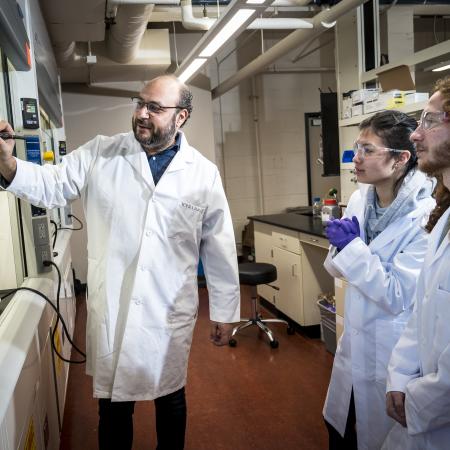A pivotal Oregon State chemistry project – funded by a $493K grant from the M.J. Murdock Charitable Trust – will create a distinctive collaboration center for academic and industrial researchers that will bring synthetic chemistry into the digital age and prepare OSU graduates to address the grand challenges of sustainable chemical manufacturing.
The three-year grant enables the launch of the Oregon State Continuous Flow Facility, an innovation center that be equipped with in-line scientific analytical tools and process units that will transform the discovery and synthesis of new molecules and materials by continuous flow (CF) methods.
Continuous flow synthesis and processing are applicable across a range of simple and complex molecules and materials for applications – ranging from health to high technology. It robustly integrates research across scientific and engineering disciplines and naturally connects to innovation and industry.
Leadership honed to provide solutions
Douglas Keszler, University Distinguished Professor of Chemistry, is leading the project. Keszler conducts research on studying elementary reactions and processing of organotin materials for semiconductor manufacturing. For decades, his research has examined solid-state and solution chemistries via integrated experimental and computational approaches. He has built and directed several large organizations, including the NSF Center for Sustainable Materials and Inpria Corp.
Other key investigators in the Murdock Trust proposal include Rich Carter, professor of chemistry; Paul Ha-Yeon Cheong, associate professor of chemistry; Marilyn Rampersad Mackiewicz, assistant professor of chemistry; May Nyman, professor of chemistry; and Kyriakos Stylianou, assistant professor of chemistry. Their work, ranging from molecular and materials synthesis to computational modeling and process control, highlights the breadth and diversity of research supported by the facility.
“This grant will be a game-changer at OSU from both academic and industrial perspectives,” said Keszler. “With the equipment and seed funding that the Murdock Trust is providing, the center will accelerate the synthesis and manufacturing of chemical products at an inflection point in digital chemical discovery and manufacturing – spurring promising industry collaborations.”
The center will work with industrial partners Valliscor, Inpria and nexTC – companies that develop and manufacture specialty chemicals for pharmaceutical, semiconductor and clean-energy markets, and MicroFlow CVO, which designs and manufactures CF process systems and their controls.
Because these companies are located in Corvallis, OSU researchers can work closely with them to design, build and integrate specialty reactors and in-line analytical instrumentation, Keszler explained. Collectively, the participants possess an unmatched set of skills and capabilities that will make the university and the region a global leader in CF-based discovery and production of specialty chemical products.
Continuous flow methodology – developing next-gen talent
The facility will also fill a critical academic need. “There is a dearth of relevant chemistry experience in CF synthesis, so very few universities are producing the graduates needed to exploit its potential. The project will prepare students for a burgeoning industry that is eager to hire qualified candidates,” Keszler said.
Support from the M.J. Murdock Charitable Trust grant will provide $450K for equipment and $53K toward seed funding to provide access to instrumentation for new OSU users seeking to develop research projects in continuous flow synthesis, processing and diagnostics.
OSU will provide a cost share of $450K, and Inpria will provide $160K. The university will provide dedicated laboratory space in the OSU Advanced Technology and Manufacturing Institute (ATAMI) to house the instruments in a dedicated 425 square-foot lab, strengthening the relationship between ATAMI and the College.
The M.J. Murdock Charitable Trust was created by the will of the late M.J. (Jack) Murdock, a co-founder of Tektronix, Inc. of Beaverton, Ore. The trust's mission is to enrich the quality of life in the Pacific Northwest by providing grants to organizations that seek to strengthen the region’s educational, social, spiritual and cultural base in creative and sustainable ways.
Saving time, energy and costs through automation
The Oregon State Continuous Flow Facility will achieve full automation of CF process flows and data collection. Researchers will integrate the analytical tools across CF process chains, which will enable digital control via real-time data collection and machine learning. The new facility will transform both discovery synthesis at OSU and the approach to sustainable manufacturing by its industrial partners.
Continuous flow methods disrupt the traditional synthetic chemist’s toolkit – batch processing, which relies on highly centralized manufacturing operations that are susceptible to supply-chain disruptions. By contrast, continuous flow moves reagents and products continuously through a series of small-volume micro-reactors and process units. This gives researchers the ability to prepare molecules not otherwise feasible via batch processing.
Other key advantages of continuous flow methods include:
- State-of-the-art control of experimental variables for enhanced product selectivity and reproducibility;
- Accelerated reaction rates via rapid mixing and heat and mass transfer;
- Integrated multiple-step reactions and processes in a single continuous flow;
- Enhanced reaction control and separation capabilities for high-purity chemical production; and
- Capabilities for unified, in-line tools to automate real-time discovery, process analysis, and optimization.
Transforming discovery synthesis and sustainable manufacturing
The Murdock Trust grant funds will be used to purchase the following equipment in the new center:
Anton Paar SAXS. Small-angle X-ray scattering (SAXS) is a non-destructive method to determine the size, shape and structure of molecules and particles from approximately 1 to 100 nm in diameter. The technique is well suited for flow chemistry, as it provides in-situ analysis and real-time data for discovery synthesis and product optimization. The proposed Anton Parr SAXS system comprises an X-ray source, small-volume flow cell, detector, and analysis software. The flow cell is capable of operating between -30 oC and 150 oC, allowing variable temperature studies to be coupled with the mixing and stoichiometric control of a CF process. Investigators chose the system based on their experience and achievements with a similar system dedicated to static measurements.
Mettler Toledo FTIR 701L. Fourier-transform infrared spectroscopy (FTIR) produces high-resolution infrared spectra of solids, liquids and gases, providing fingerprints of molecules useful for their identification. The Mettler Toledo FTIR 701L is equipped with sampling technologies to determine reaction initiation, progression and endpoint, so it can be readily integrated into a CF system. The package comprises a TEMCT detector, a 702L base spectrometer, 50-μL heated sample flow cell, and analysis software. It employs Attenuated Total Reflection (ATR) to improve sensitivity. Real-time data collection enables studies of reaction kinetics and feedback to modulate reagent compositions and flow-system parameters for automating synthesis and improving processes.
Bruker NMR Console and Insight Probe. Nuclear Magnetic Resonance (NMR) Spectroscopy is the dominant method for establishing the identity and structures of small and biomolecules in solution. Upgrading an existing Bruker 400-MHz spectrometer with a new console will enable analyses via a Bruker Insight Probe, which is a flow-based unit. The Probe has a measurement volume or 250 μl, and it operates at pressures up to 10 bar with flow rates from 0.5 to 4 mL/min. The system provides high sensitivity and multi-nuclear capabilities to study reaction kinetics across a wide range of molecules and materials.
Buchi Spray Drying System. Spray drying is a technique that employs compressed air or nitrogen to atomize an aqueous or organic solution of a chemical precursor. As the solvent evaporates, the precursor reacts to form pure powders or composites. The Buchi Mini Spray B-290 Advanced is a self-contained spray dryer capable of producing particle sizes from 200 nm to 5 μm. The system supports the synthesis of a variety of inorganic and organometallic materials.
Ocean Insight UV-Vis. Ultraviolet-visible light spectroscopy (UV-Vis) is a technique to identify functional groups in molecules, electronic states and ligand-to-metal charge transfer defining oxidation state and bonding, and to monitor and assess nanoparticle synthesis. Data are acquired in either transmission or reflectance modes. The Ocean Insight UV-Vis spectrometer with microfluidic cell, UV-Vis light source, spectrometer and detector readily integrates into the CF system to provide real-time data collection under reaction conditions.
The grant also provides funds to design and build a Control Process System for automated execution of all experiments and data collection. This automation enables pathways to build machine-learning algorithms into discovery and optimization processes.
Looking to the future
The Oregon State Continuous Flow Facility will enhance the College of Science’s drive to foster a culture of innovation and encourage discoveries that make their way into the economy. Keszler, who served as associate dean for research and graduate studies in the College from 2014 to 2020, strengthened this aim by educating students and faculty about innovation, and institutionalizing a culture of innovation and in translating basic research discoveries to application.
“Doug Keszler has achieved outstanding success in connecting innovation and industry and bringing research to market. This new instrumentation will be foundational to leveraging incredible growth opportunities going forward,” said Roy Haggerty, dean of the College of Science.




